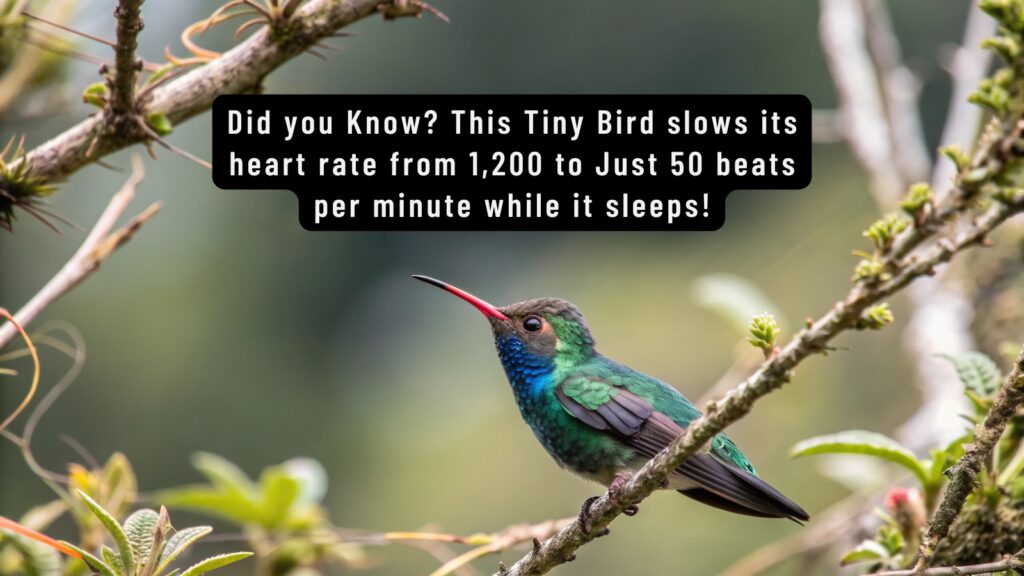When you think about hummingbirds, you probably picture them darting between flowers or hovering mid-air with their wings beating at mind-boggling speeds. But what happens when these energetic birds call it a day?
Recent scientific discoveries about their nighttime behaviour have left researchers amazed, particularly regarding how broad-billed hummingbirds manage their energy during dark hours.
The Fascinating Night Life of Broad-billed Hummingbirds
Imagine running a marathon all day, every day. That’s essentially what hummingbirds do, burning through energy at an incredible rate.
Their hearts beat up to 1,200 times per minute during the day, and they need to feed every 15-20 minutes to maintain their high-energy lifestyle. But at night, something remarkable happens.
As darkness falls, broad-billed hummingbirds undergo an incredible transformation. Their normally supercharged bodies switch into an energy-saving mode called torpor, a state that’s similar to what bears experience during hibernation, but on a daily basis.

Related post: The Broad-billed Hummingbird: A Complete Guide.
Understanding Bird Torpor: A Nightly Survival Strategy
When a broad-billed hummingbird enters torpor, the changes in its body are dramatic. Its heart rate slows from 1,200 beats per minute to just 50.
Their body temperature drops significantly from their normal daytime temperature of about 40°C (104°F), with the exact temperature varying depending on environmental conditions and the specific species. Some hummingbirds can even survive body temperature drops to as low as 10°C (50°F).
These tiny birds often appear lifeless, hanging upside down from their perch due to their completely relaxed muscles.
This incredible adaptation helps them solve a crucial survival problem. Hummingbirds have such fast metabolisms that they’re always just hours away from running out of energy. Without torpor, they wouldn’t survive the night when they can’t feed on nectar.
How Nighttime Bird Behavior Changes Everything We Know
Scientists studying hummingbird sleep have discovered that this isn’t just a simple shutdown process. During torpor, these birds go through several distinct phases:
Their metabolism slows dramatically, reducing energy use by up to 95%. This reduction is so extreme that their breathing becomes so slow it’s barely detectable. Their muscles relax completely, causing them to hang upside down from their perch, appearing almost lifeless to observers.
When morning approaches, something equally remarkable happens. About an hour before sunrise, their bodies begin to warm up.
Their heart rates increase, and their breathing returns to normal. The entire recovery process, known as arousal, typically takes 20-30 minutes. By the time the sun rises, they’re ready to resume their energy-intensive day of feeding and flying.
The Science Behind This Survival Technique
Recent research has revealed that this process is even more sophisticated than previously thought. The broad-billed hummingbird’s brain appears to trigger torpor based on both internal and external cues, including light levels and energy reserves.
Their bodies have evolved remarkable adaptations to handle these extreme daily temperature and metabolic changes – a feat that would be fatal for most other birds.
Final Thoughts
The discovery of how broad-billed hummingbirds manage their nighttime energy needs shows us just how incredible nature’s adaptations can be. These tiny birds, weighing less than a nickel, have developed one of the most efficient energy-saving systems in the animal kingdom. What other secrets might these remarkable creatures be hiding?
If you found this article helpful, please share it with fellow nature enthusiasts who might be interested in learning about these fascinating birds. Thanks for reading!
Frequently Asked Questions (FAQ: What Broad-billed Hummingbirds Do at Night)
Q: How long do hummingbirds stay in torpor?
A: Broad-billed hummingbirds typically remain in torpor for 8-10 hours each night. The exact duration depends on the length of the night and environmental conditions.
Q: Can hummingbirds die during torpor?
A: While hummingbirds in torpor may appear dead due to their extremely slow breathing and heartbeat, this is a natural and safe state for them. However, they are more vulnerable to predators during this time.
Q: Do all hummingbird species enter torpor?
A: While most hummingbird species can enter torpor, the behaviour is particularly well-documented in broad-billed hummingbirds. Different species may use torpor to varying degrees depending on their environment and energy needs.
Q: How quickly can hummingbirds recover from torpor?
A: Hummingbirds typically take 20-30 minutes to fully recover from torpor. The warming process begins about an hour before sunrise, allowing them to be ready for their first meal of the day.
Q: How does torpor affect a hummingbird’s body temperature?
A: During torpor, hummingbirds experience a dramatic drop in body temperature from their normal 40°C (104°F). The exact temperature can vary significantly depending on the species and environmental conditions, with some hummingbirds capable of surviving body temperature drops to as low as 10°C (50°F).
Q: Why don’t hummingbirds just eat more during the day to survive the night?
A: Despite their small size, hummingbirds can’t store enough energy to maintain their high metabolism throughout the night. Torpor is their evolutionary solution to this energy management challenge.
Citations:
Shankar, A., Powers, D.R., Dillon, M.E. et al. (2022). “A heterothermic spectrum in hummingbirds.” Journal of Experimental Biology, 225(2), jeb243208.
URL: https://journals.biologists.com/jeb/article/225/2/jeb243208/274119/A-heterothermic-spectrum-in-hummingbirds
“Hummingbirds exert fine control over body heat” – Cornell Chronicle
URL: https://news.cornell.edu/stories/2022/02/hummingbirds-exert-fine-control-over-body-heat
